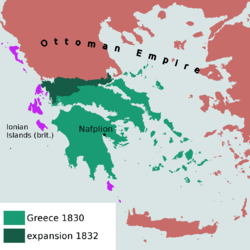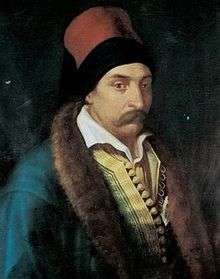First Hellenic Republic
The First Hellenic Republic (Greek: Αʹ Ελληνική Δημοκρατία) is a historiographical term for the provisional Greek state during the Greek War of Independence against the Ottoman Empire.[1][2] From 1822 until 1827, it was known as the Provisional Administration of Greece, and between 1827 and 1832, it was known as the Hellenic State.
Provisional Administration of Greece (1822–1827) Hellenic State (1827–1832) Προσωρινὴ Διοίκησις τῆς Ἑλλάδος Ἑλληνικὴ Πολιτεία | |||||||||||
|---|---|---|---|---|---|---|---|---|---|---|---|
| 1822–1832 | |||||||||||
 | |||||||||||
| Status | Unrecognized state (1822–1830) Provisional government (1822–1827) | ||||||||||
| Capital | Nafplio | ||||||||||
| Common languages | Greek | ||||||||||
| Religion | Greek Orthodox | ||||||||||
| Government | Unitary presidential republic | ||||||||||
| President of the Executive | |||||||||||
• 1822–1823 (first) | Alexandros Mavrokordatos | ||||||||||
• 1826–1827 (last) | Andreas Zaimis | ||||||||||
| Governor | |||||||||||
• 1827–1831 | Ioannis Kapodistrias | ||||||||||
• 1831–1832 | Augustinos Kapodistrias | ||||||||||
| Legislature | National Assembly | ||||||||||
| History | |||||||||||
• Start of Greek Revolution | February 23, 1821 (Wallachia) mid-March 1821 (Peloponnese) | ||||||||||
| January 1 1822 | |||||||||||
| March 22, 1829 | |||||||||||
| February 3, 1830 | |||||||||||
| August 8 1832 | |||||||||||
| August 30, 1832 | |||||||||||
| Currency | Phoenix | ||||||||||
| |||||||||||
| Today part of | |||||||||||
The term is used by academics and the Greek government to emphasize the constitutional and democratic nature of the revolutionary regime prior to the establishment of the independent Kingdom of Greece, and associate this period of Greek history with the later Second and Third Republics.[3][4]
History
In the first stages of the 1821 uprising, various areas elected their own regional governing councils. These were replaced by a central administration at the First National Assembly of Epidaurus in early 1822, which also adopted the first Greek Constitution, marking the birth of the modern Greek state. The councils continued in existence, however, and central authority was not firmly established until 1824/1825. The new state was not recognized by the Great Powers of the day, which, after initial successes, was threatened with collapse both from within due to civil war and from without through the victories of the Turco-Egyptian army of Ibrahim Pasha.[1]
By 1827 the Greek revolution had almost been extinguished on the mainland, but by this time the Great Powers had come to agree to the formation of an autonomous Greek state under Ottoman suzerainty, as stipulated in the Treaty of London. Ottoman refusal to accept these terms led to the Battle of Navarino, which effectively secured complete Greek independence.
In 1827, the Third National Assembly at Troezen established the Hellenic State (Ἑλληνικὴ Πολιτεία) and selected Count Ioannis Kapodistrias as Governor of Greece. Therefore, this period is often called Governorate (Greek: Κυβερνείο). After his arrival in Greece in January 1828, Kapodistrias actively tried to create a functional state and redress the problems of a war-ravaged country, but was soon embroiled in conflict with powerful local magnates and chieftains.[2]

Kapodistrias was assassinated by political rivals in 1831, plunging the country into renewed civil strife. He was succeeded by his brother Augustinos, who was forced to resign after six months. The Fifth National Assembly at Nafplion drafted a new royal constitution, while the three "Protecting Powers" (Great Britain, France and Russia) intervened, declaring Greece a Kingdom in the London Conference of 1832, with the Bavarian Prince Otto of Wittelsbach as king.
Heads of the Executive
The following were the heads of government for the First Hellenic Republic:[5]
Provisional Administration of Greece (1822–1827)
| Head of State | Term of office | Title | ||||
|---|---|---|---|---|---|---|
| № | Portrait | Name (Birth–Death) |
Took office | Left office | Time in office | |
| 1 |  |
Alexandros Mavrokordatos Αλέξανδρος Μαυροκορδάτος (1791–1865) |
13 January 1822 | 10 May 1823 | 1 year, 117 days | President of the Executive |
| 2 |  |
Petros Mavromichalis Πέτρος Μαυρομιχάλης (Πετρόμπεης) (1765–1848) |
10 May 1823 | 31 December 1823 | 235 days | President of the Executive |
| 3 |  |
Georgios Kountouriotis Γεώργιος Κουντουριώτης (1782–1858) |
31 December 1823 | 26 April 1826 | 2 years, 116 days | President of the Executive |
| 4 |  |
Andreas Zaimis Ανδρέας Ζαΐμης (1791–1840) |
26 April 1826 | 14 April 1827 | 353 days | President of the Government Commission |
Hellenic State (1827–1832)
| Governor | Term of office | Political party | ||||
|---|---|---|---|---|---|---|
| № | Portrait | Name (Birth–Death) |
Took office | Left office | Time in office | |
| 1 |  |
Ioannis Kapodistrias Ιωάννης Καποδίστριας (1776–1831) |
14 April 1827 | 9 October 1831 (Assassinated) |
4 years, 178 days | Russian Party |
| 2 |  |
Augustinos Kapodistrias Αυγουστίνος Καποδίστριας (1778–1857) |
9 October 1831 | 23 March 1832 (Resigned) |
166 days | Russian Party |
See also
References
- "Ottoman Rule and the War of Independence", Greek, Wiley-Blackwell, pp. 371–378, 2010-08-02, ISBN 978-1-4443-1891-3, retrieved 2020-04-27
- Llc, Books (2010). Greek War of Independence: Morea Expedition, Massacres During the Greek Revolution, Souliotes, Background of the Greek War of Independence, Filiki Eteria, Armatoloi, Spinalonga, Greek Civil Wars of 1824-1825, Gramvousa, Klepht, Aegean Anti-Piracy Operation. General Books. ISBN 978-1-156-77377-2.
- "Which Country Is Also Called The Hellenic Republic?". WorldAtlas. Retrieved 2020-04-27.
- "Constitutional History". www.hellenicparliament.gr. Retrieved 2020-04-27.
- "Countries Go-Gu". rulers.org. Retrieved 2020-04-27.
.svg.png)

